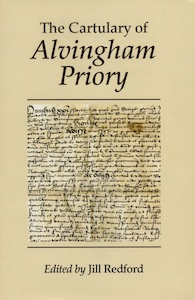
The documents are presented here with introduction and notes.
Jill Redford gained her PhD at the University of York and is assistant archivist to the Company of Merchant Adventurers of the City of York.

Volume KM2 The Cartulary of Alvingham Priory
Editor: Jill Redford
Publication Date: 2018
Size: 235 x 155 mm
Language: Latin and English with a few entries in Anglo-Norman and Hebrew
Publisher: A Lincoln Record Society publication published by the Boydell Press an imprint of Boydell & Brewer Ltd PO Box 9, Woodbridge, Suffolk, IP12 3DF and of Boydell & Brewer Inc. 668 Mt Hope Avenue, Rochester, NY 14620-2731, USA
Website: www.boydell.com
Printed & bound by TJ International Ltd., Padstow, Cornwall
This publication is printed on acid-free paper
ISBN 978 1 910653 04 3
Content
Contents, 1 page
Preface, 1 page
Bibliography, 9 pages
Abbreviations, 3 pages
Introduction, 26 pages
Editorial Method, 2 pages
The Cartulary, 504 pages
Appendix: The Genealogical Tables Referred to in the Text, 6 pages
Index, 60 pages
Alvingham Priory (founded in 1155), situated just to the north-east of Louth in Lincolnshire, was one of the famous Gilbertine houses of the county: double houses of monks and nuns following the rule of St Gilbert of Sempringham. Its cartulary, created circa 1264, contains over 1,300 entries. Most are copies of charters granting lands, property, rents and privileges, but it also includes genealogies of benefactors, valuations of the priory's property, memoranda and accounts of disputes. Many documents record the names of those who entered the community as nuns or canons, or who were associating themselves with it by requests for confraternity or burial, throwing light on the way in which local families interacted with the priory and with each other. Meanwhile, the details of lands granted to the priory provide information about local land-holders, field- and place-names, farming practices and the various activities which supported the religious community. Although its holdings were scattered across north-east Lincolnshire, from Conesby to Boston and from Lincoln to Saltfleetby, much of the priory's property was located in the low-lying lands east of Louth, and its charters demonstrate the importance of the area's waterways, bridges, ditches and banks, not just as geographical boundaries but as resources to be exploited, maintained and, importantly, to be shared in a harmonious way by the local community, religious and lay.
The documents are presented here with introduction and notes.
Jill Redford gained her PhD at the University of York and is assistant archivist to the Company of Merchant Adventurers of the City of York.